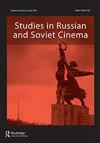Nonverbal corporeal signs in the works of Aleksandr Sokurov’s students
IF 0.4
0 FILM, RADIO, TELEVISION
引用次数: 1
Abstract
ABSTRACT Nonverbal semiotics offers new approaches to the analysis of corporeal codes that define cultural interpretations, social communications and creative processes of art works. Grigorii Kreidlin has singled out three groups of nonverbal corporeal signs, which help analyse more concisely the embodiment in contemporary cinema of a protagonist who, at the level of body techniques (according to Mauss), becomes a conductor for a complex system of interactions between man and the world. The protagonist’s selfhood is called into question by an elusive space (Augé’s ‘non-places’), which defines the motif of a wandering hero, who tries to escape from roles imposed by society but is unable to achieve his dream. The films made between 2017–2022 by Kira Kovalenko, Kantemir Balagov, Vladimir Bitokov and Aleksandr Zolotukhin – graduates of the first director’s workshop by Aleksandr Sokurov – are analysed from the point of view of nonverbal corporeal signs. In their works, corporeal techniques of performers and characters express issues of violence, as is evident in the use of regulator gestures that halt dialogue in family relations; illustrator gestures that designate non-freedom of corporeal expressions in choreographed dances; and emblem gestures that bring corporeality to the level of ‘illness as metaphor’.Aleksandr Sokurov学生作品中的非语言肢体符号
非语言符号学为分析定义文化解释、社会交流和艺术作品创作过程的身体密码提供了新的方法。格里高利·克雷德林(Grigorii Kreidlin)挑出了三组非语言的身体符号,这有助于更简洁地分析当代电影中主人公的化身,在身体技巧的层面上(根据莫斯的说法),主角成为了人与世界互动的复杂系统的指挥者。主人公的自我被一个难以捉摸的空间(奥格鲁的“非场所”)所质疑,这定义了一个流浪英雄的母题,他试图逃离社会强加的角色,但却无法实现他的梦想。基拉·科瓦连科、坎特米尔·巴拉戈夫、弗拉基米尔·比托科夫和亚历山大·佐洛图欣是亚历山大·索库罗夫第一届导演研修班的毕业生,他们在2017-2022年间拍摄的电影从非语言身体符号的角度进行了分析。在他们的作品中,表演者和人物的身体技巧表达了暴力问题,这在使用停止家庭关系对话的调节手势中是显而易见的;插画手势,指定非自由的身体表达编排的舞蹈;象征的手势将肉体带到“疾病作为隐喻”的水平。
本文章由计算机程序翻译,如有差异,请以英文原文为准。
求助全文
约1分钟内获得全文
求助全文

 求助内容:
求助内容: 应助结果提醒方式:
应助结果提醒方式:


